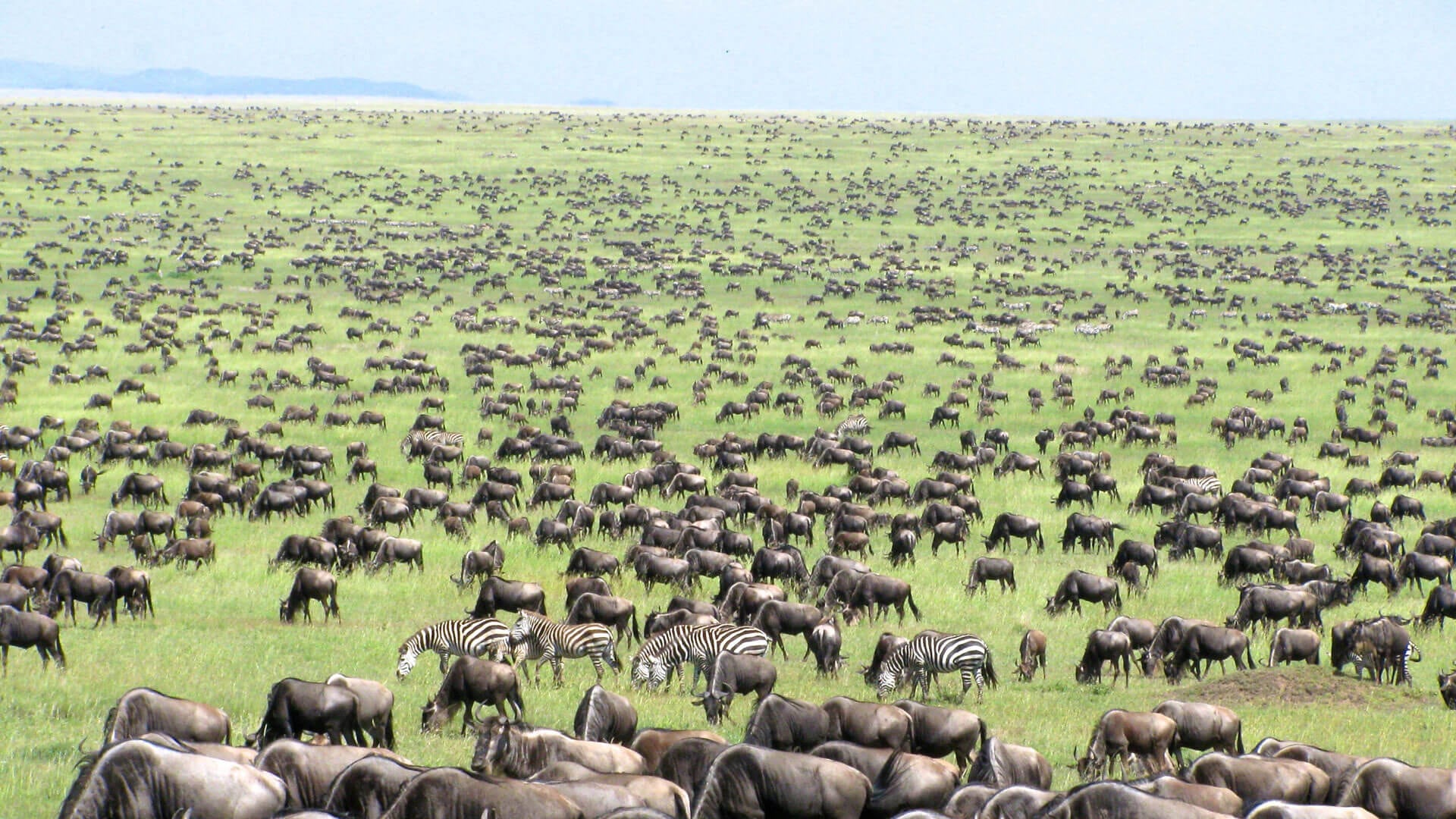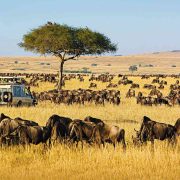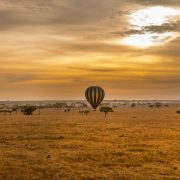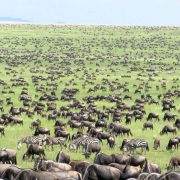
How Does the Wildebeest Migration Work?
- Briefly introduce the concept of the wildebeest migration and its importance in the Serengeti ecosystem
- Describe the general route of the migration, including the start and end points
- Mention any notable landmarks or areas along the route
- Explain that the migration follows a predictable annual pattern
- Describe the factors that influence the timing of the migration, such as rainfall and grass growth
- Mention that the wildebeest are accompanied by other animals during the migration, such as zebras, gazelles, and predators
- Explain how the presence of these animals helps to maintain the ecosystem
- Discuss any threats to the wildebeest migration, such as habitat loss and human-wildlife conflict
- Mention any conservation efforts or initiatives aimed at protecting the migration
- Recap the main points of the post
- Encourage readers to learn more about the wildebeest migration and the importance of conserving it.
=> Introduction
The wildebeest migration is an annual phenomenon in which hundreds of thousands of wildebeest and other animals, such as zebras and gazelles, move in a circular pattern across the Serengeti ecosystem in search of food and water. This migration is considered one of the greatest wildlife spectacles on earth and is a major tourist attraction in the Serengeti region of Tanzania and Kenya. The wildebeest migration is important for the Serengeti ecosystem because it helps to maintain the balance of the grasslands. The wildebeest and other herbivores graze on the grass, which stimulates new growth and helps to prevent the buildup of excess vegetation. This, in turn, provides food and habitat for a wide range of animals, including predators such as lions and hyenas. The migration also helps to disperse seeds and fertilize the soil, promoting the overall health and diversity of the ecosystem.=> The wildebeest migration route
The wildebeest migration follows a circular route within the Serengeti ecosystem, which includes parts of Tanzania and Kenya. The migration typically begins in the southern Serengeti in Tanzania around December, when the wildebeest give birth to their calves. From there, the herd moves northward through the Serengeti National Park and into the Maasai Mara National Reserve in Kenya, following the rains and the growth of new grass. Along the way, the wildebeest pass through several notable landmarks and areas, including the Grumeti Reserve, the Western Corridor, and the Mara River. The Grumeti Reserve is known for its large crocodile population, which can be seen preying on the wildebeest as they attempt to cross the Grumeti River. The Western Corridor is a narrow strip of land between the Grumeti River and the Mara River, where the wildebeest often face significant challenges as they try to avoid predators and find food and water. The Mara River is the final obstacle for the wildebeest, as they must cross it to reach the Maasai Mara. The wildebeest remain in the Maasai Mara for several months, before beginning the return journey to the southern Serengeti in October or November. The migration usually takes around 8-9 months to complete and covers a distance of approximately 1,800 miles (2,900 kilometers).=> The wildebeest migration route
The wildebeest migration follows a predictable annual pattern, with the wildebeest moving in a circular route from the southern Serengeti to the Maasai Mara and back again. The timing of the migration is influenced by several factors, including rainfall and grass growth. The wildebeest follow the rains and the growth of new grass as they move across the Serengeti. The rainy season in the Serengeti typically begins in November and ends in May, with the heaviest rainfall occurring between December and April. The growth of new grass is closely tied to the rains, as the grass needs water to grow. As the grass grows, the wildebeest move to new areas in search of food. The timing of the wildebeest migration can vary from year to year depending on the amount and distribution of rainfall. In years with above-average rainfall, the grass may grow faster and the wildebeest may begin their migration earlier. In years with below-average rainfall, the grass may grow more slowly and the wildebeest may delay their migration. Despite these variations, the wildebeest migration generally follows a predictable annual pattern.=> The role of other animals in the wildebeest migration
The wildebeest are not alone during their migration; they are accompanied by a wide range of other animals, including zebras, gazelles, and predators. These animals play an important role in the ecosystem, helping to maintain the balance of the grasslands and supporting the overall health of the Serengeti ecosystem. The zebras and gazelles, like the wildebeest, are herbivores that graze on the grass, stimulating new growth and helping to prevent the buildup of excess vegetation. This benefits the grasslands and the animals that depend on them, including predators such as lions and hyenas. The predators, in turn, help to keep the populations of the herbivores in check, preventing overgrazing and maintaining the balance of the ecosystem. The presence of these animals during the wildebeest migration creates a complex and dynamic ecosystem, with each species playing a role in the overall health and functioning of the Serengeti. The migration of the wildebeest, zebras, and gazelles, and the presence of the predators, all contribute to the richness and diversity of the Serengeti ecosystem.=> The impact of human activity on the wildebeest migration
The wildebeest migration is an important and iconic part of the Serengeti ecosystem, but it is not without its challenges and threats. Habitat loss and human-wildlife conflict are two major threats to wildebeest migration. Habitat loss is a significant threat to the wildebeest migration, as it reduces the number of available grasslands and other resources needed by the wildebeest and other animals. Habitat loss can be caused by a variety of factors, including a land conversion for agriculture, urbanization, and infrastructure development. Human-wildlife conflict is another threat to the wildebeest migration. As the wildebeest and other animals move through the Serengeti, they may come into contact with human settlements and farming operations, leading to conflict and potential harm to both humans and animals. This conflict can be caused by a variety of factors, such as competition for resources, crop raiding, and accidental collisions with vehicles. There are several conservation efforts and initiatives in place to protect the wildebeest migration and the Serengeti ecosystem. These include the establishment of protected areas such as national parks and reserves, efforts to reduce habitat loss and mitigate the impacts of human activities, and initiatives to address human-wildlife conflict. These efforts aim to ensure the long-term survival of the wildebeest migration and the overall health and viability of the Serengeti ecosystem.=> Conclusion
In summary, the wildebeest migration is an annual phenomenon in which hundreds of thousands of wildebeest and other animals move in a circular pattern across the Serengeti ecosystem in search of food and water. The migration is important for the Serengeti ecosystem because it helps to maintain the balance of the grasslands and supports the overall health and diversity of the ecosystem. The wildebeest migration follows a predictable annual pattern and is influenced by factors such as rainfall and grass growth.
The wildebeest are accompanied by other animals during the migration, including zebras, gazelles, and predators, which all play a role in the functioning of the ecosystem. The wildebeest migration is threatened by habitat loss and human-wildlife conflict, but there are conservation efforts in place to protect the migration and the Serengeti ecosystem.
The wildebeest migration is a remarkable and iconic natural event, and it is important to conserve it for future generations. If you are interested in learning more about the wildebeest migration and the Serengeti ecosystem, there are many resources available, including books, documentaries, and conservation organizations. By learning about and supporting the conservation of the wildebeest migration, we can all play a role in protecting this unique and important part of the natural world.



